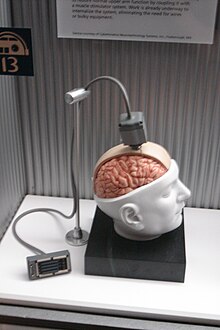Digital Media Concepts/Cyberware
In science fiction, especially the cyberpunk genre, cyberware (or cybernetics) is a term referring to mechanical components surgically grafted onto the human’s body that interface with the brain or central nervous system. They are commonly used to enhance physical and mental abilities or allow a person to interact with a machine - typically a computer - without using their hands. In the real world, the technology is relatively recent.
Currently, scientists focus on two aspects: brain-machine interfaces and prosthetic.
Brain-Machine Interface
[edit | edit source]
In works of fiction such as William Gibson’s Neuromancer, the tabletop RPGs Shadowrun and Cyberpunk, a datajack or another piece of cyberware/device with similar functions allow an individual to broadcast their consciousness into an immersive simulated reality (or cyberspace) or use a machine via thoughts alone. The installation of a datajack is difficult but necessary. Without it acting as a translator, communication between mind and computer would be impossible because the information presented by human thoughts are incomprehensible to the computer.
As of the present, it has been proven that it’s possible to interact with a machine using the mind. Notable examples included a monkey successfully feeding itself with a robotic arm at the University of Pittsburgh School of Medicine simply by thinking in 2008[1]. 10 years later, people with paralysis were able to write text messages and emails, play a virtual piano and other host of daily activities on a tablet when equipped with the BrainGate brain implant.[2]
Full-brain emulation, such as the brain-scan technology in the video-game SOMA, is currently unfeasible. In 2013, it took 40 minutes for the K computer to process a single second of the brain processing time.[3]. Experts estimate that computers as powerful as the human brain may come to be by 2025.[4]
Prosthetics
[edit | edit source]
In cyberware, prosthetics are modernized in order to better mimic the natural function and movement of an organic limb, incorporating the uses of microprocessors to further bridge the gap between man and machine. To this end, procedure such as the Agonist-antagonist Myoneural Interface (AMI) has been created and conducted. As a result, Jim Ewing, who lost his leg in a climbing accident at Cayman Islands, gained a synthetic substitute which he could feel and move around as if it was a part of his body.[5]
Cyberware-prostheses are also used to replace lost senses (cochlear implant), improve the failing body (pacemaker), and possibly create new sensations. For example, Neil Harbisson, the world's first legally-recognized cyborg artist who was born with Achromatopsia, has an antenna implanted in his skull which he uses to feel and hear colors as vibrations. Moon Ribas, a fellow cyborg artist and co-founder of the Cyborg Foundation alongside Harbisson, has online seismic sensors implanted in her elbows which allows her to feel earthquakes all over the world as vibrations regardless of her current location.[6]
References
[edit | edit source]- ↑ "Science & Technology: Monkey Uses Brain Power to Feed Itself With Robotic Arm" (June 9, 2008) from https://web.archive.org/web/20090910034547/http://www.chronicle.pitt.edu/?p=1478
- ↑ Patients with paralysis use brain signals to operate a tablet (November 29, 2018) from https://engineering.stanford.edu/magazine/article/patients-paralysis-use-brain-signals-operate-tablet
- ↑ "Simulating 1 second of human brain activity takes 82,944 processors" (August 5, 2013) from https://www.extremetech.com/extreme/163051-simulating-1-second-of-human-brain-activity-takes-82944-processors
- ↑ "When Will Computers Be as Powerful as the Human Brain?" (May 14, 2013) from https://gizmodo.com/when-will-computers-be-as-powerful-as-the-human-brain-505499450
- ↑ "Pioneering surgery makes a prosthetic foot feel like the real thing" (May 30, 2018) from https://www.statnews.com/2018/05/30/pioneering-amputation-surgery-prosthetic-foot/
- ↑ "Moon Ribas: The cyborg dancer who can detect earthquakes" (October 23, 2018) from https://www.cnn.com/style/article/moon-ribas-cyborg-smart-creativity/index.html
